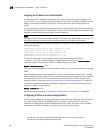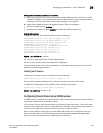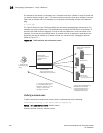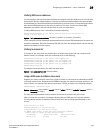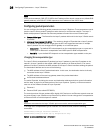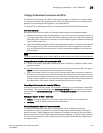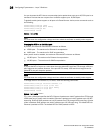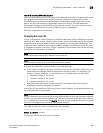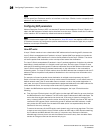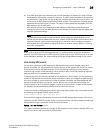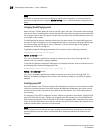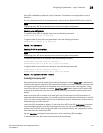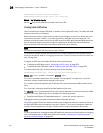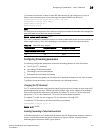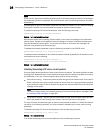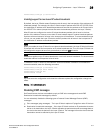
810 PowerConnect B-Series FCX Configuration Guide
53-1002266-01
Configuring IP parameters – Layer 3 Switches
26
NOTE
You can specify an IP address used for an interface on the Layer 3 Switch, but do not specify an IP
address in use by another device.
Configuring ARP parameters
Address Resolution Protocol (ARP) is a standard IP protocol that enables an IP Layer 3 Switch to
obtain the MAC address of another device interface when the Layer 3 Switch knows the IP address
of the interface. ARP is enabled by default and cannot be disabled.
NOTE
Layer 2 Switches also support ARP. The description in “How ARP works” also applies to ARP on Layer
2 Switches. However, the configuration options described later in this section apply only to Layer 3
Switches, not to Layer 2 Switches.
How ARP works
A Layer 3 Switch needs to know a destination MAC address when forwarding traffic, because the
Layer 3 Switch encapsulates the IP packet in a Layer 2 packet (MAC layer packet) and sends the
Layer 2 packet to a MAC interface on a device directly attached to the Layer 3 Switch. The device
can be the packet final destination or the next-hop router toward the destination.
The Layer 3 Switch encapsulates IP packets in Layer 2 packets regardless of whether the ultimate
destination is locally attached or is multiple router hops away. Since the Layer 3 Switch IP route
table and IP forwarding cache contain IP address information but not MAC address information, the
Layer 3 Switch cannot forward IP packets based solely on the information in the route table or
forwarding cache. The Layer 3 Switch needs to know the MAC address that corresponds with the IP
address of either the packet locally attached destination or the next-hop router that leads to the
destination.
For example, to forward a packet whose destination is multiple router hops away, the Layer 3
Switch must send the packet to the next-hop router toward its destination, or to a default route or
default network route if the IP route table does not contain a route to the packet destination. In
each case, the Layer 3 Switch must encapsulate the packet and address it to the MAC address of a
locally attached device, the next-hop router toward the IP packet destination.
To obtain the MAC address required for forwarding a datagram, the Layer 3 Switch does the
following:
• First, the Layer 3 Switch looks in the ARP cache (not the static ARP table) for an entry that lists
the MAC address for the IP address. The ARP cache maps IP addresses to MAC addresses. The
cache also lists the port attached to the device and, if the entry is dynamic, the age of the
entry. A dynamic ARP entry enters the cache when the Layer 3 Switch receives an ARP reply or
receives an ARP request (which contains the sender IP address and MAC address). A static
entry enters the ARP cache from the static ARP table (which is a separate table) when the
interface for the entry comes up.
To ensure the accuracy of the ARP cache, each dynamic entry has its own age timer. The timer
is reset to zero each time the Layer 3 Switch receives an ARP reply or ARP request containing
the IP address and MAC address of the entry. If a dynamic entry reaches its maximum
allowable age, the entry times out and the software removes the entry from the table. Static
entries do not age out and can be removed only by you.



